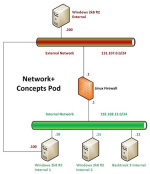

This work by the National Information Security and Geospatial Technologies Consortium (NISGTC), and except where otherwise noted, is licensed under the Creative Commons Attribution 3.0 Unported License.
Development was funded by the Department of Labor (DOL) Trade Adjustment Assistance Community College and Career Training (TAACCCT) Grant No. TC-22525-11-60-A-48; The National Information Security, Geospatial Technologies Consortium (NISGTC) is an entity of Collin College of Texas, Bellevue College of Washington, Bunker Hill Community College of Massachusetts, Del Mar College of Texas, Moraine Valley Community College of Illinois, Rio Salado College of Arizona, and Salt Lake Community College of Utah.
This workforce solution was funded by a grant awarded by the U.S. Department of Labor's Employment and Training Administration. The solution was created by the grantee and does not necessarily reflect the official position of the U.S. Department of Labor. The Department of Labor makes no guarantees, warranties or assurances of any kind, express or implied, with respect to such information, including any information on linked sites, and including, but not limited to accuracy of the information or its completeness, timeliness, usefulness, adequacy, continued availability or ownership.
Please review the content-specific requirements for Network+ labs.
Network+ labs are supported using the Network+ Pod. To enable the Network+ labs, check the box for "NISGTC Network+" in the class settings. This must be done for each class requiring access to the labs.

| Lab | Title | Objective |
|---|---|---|
| 1 | The OSI Model |
|
| 2 | Types of Networks |
|
| 3 | TCP/IP Utilities |
|
| 4 | IPv4 vs IPv6 – Calculating, Configuring and Testing |
|
| 5 | TCP/IP Protocols – Other Key Protocols |
|
| 6 | Network Management |
|
| 7 | Remote Access - RDP |
|
| 9 | Network Troubleshooting |
|
| 10 | Network Security - Firewalls |
|
| 11 | Business Continuity - Disaster Recovery |
|
| 12 | TCP/IP Protocols - The Core Protocols |
|